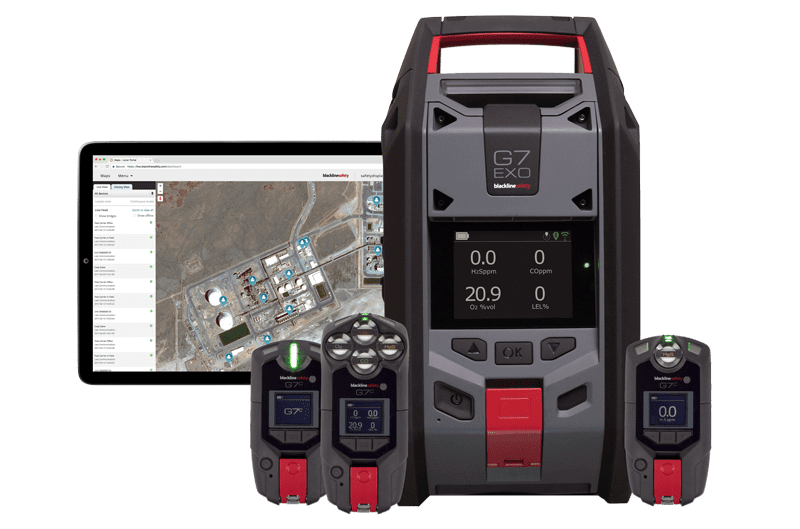As the oil and gas industry continues to evolve, a heightened sense of safety accompanies the growth. While no one wants to see an employee incur an injury, the trend to raise safety awareness seems partially driven by the desire to keep expenditures at a minimum. That concept includes the costs associated with workplace safety incidents.
Various programs, policies and directives have been instituted by companies to beef up safety cultures but, in many cases, human error still prevails as the culprit of incidents or injury. Although programs are in place, their effectiveness is driven by the human beings that use them daily. As a result, the search for a more sophisticated method to ensure a safe workplace continues to mount in responding to the injuries and incidents that threaten safety. To overcome the risk of injury or incident, research and development teams diligently work on engineering technology-driven solutions as the premier response.
Companies like Blackline Safety have stepped up to the proverbial plate to offer equipment-based solutions to provide coverage of many high-risk activities, such as gas detection, lone worker management and mechanical support of bodily motion. With the ability to trust the equipment that is supplied, the potential for human error decreases, leading to less exposure to incidents and injury.
Successful Performance
According to Sean Stinson, chief growth officer of Blackline Safety, wearable components can enhance personal safety while simultaneously removing human error. Products like the company’s G7 personal gas detection monitor enhance personal safety while monitoring and measuring harmful gases, as well as dangerous increases and decreases in oxygen levels. Although this appears to mirror other units used in the field, Blackline Safety’s advancement in design enables its solution to provide much more.
“Many people shut gas detectors down or off when they alarm,” says Stinson. “With our units, the data is accessible to leaders, like safety managers, who can then deal with the actual results of the gas readings, as well as the individual who fails to acknowledge the alert.”
Because the data can be seen by more than just the end user, the Blackline unit offers enhanced quality workplace safety. While human error can lead to ignoring the alarm itself, technological advancement circumvents that error, making its significance much greater. The addition of the G7’s push-to-talk capability and 24/7 live monitoring allows the units to serve as a mechanical solution to lone worker programs.
Kenny Graves of K-Group, LLC, in Mississippi, has served the onshore and offshore sectors of the oil and gas industry as a safety professional for nearly ten years and indicates the shift to technology-driven solutions yields impressive results. He has witnessed first-hand how Blackline Safety’s G7 wearable enhances workplace safety.

“The partnership between the monitoring and communication functions brings confidence to those who use the devices,” says Graves.
Safety trends are more expansive than just wearable solutions. Further developments indicate a shift in attempting to remove the potential of exposure. Historically, companies have tried to remove a potential hazard but, when unable to do so, the first measures enacted were engineering controls such as safeguards. Administrative controls have served as secondary measures with programs and procedures drafted to guide the workforce when introduced to the potential hazard.
Personal protective equipment, such as hard hats and safety glasses, has served individuals as the last protection barrier. Technological safety solutions offer a different directive. More companies have turned to technology to remove humans from the line of fire, better known as taking the person out of the equation.
The EXO area monitor provided by Blackline Safety accomplishes this very task. It can receive up to four hoses, monitoring four locations simultaneously. Because the unit is cloud-connected, the data can be accessed remotely, eliminating the human being present to record readings manually. The technology eliminates the potential exposure by not having a life in potential harm. Stinson says this concept adds to its gas detection lineup and measures gas powered through a 100-day life battery.
Limited Buy-In
While technological advancement seems a sure thing, the trend of dependence and use has increased – with exceptions. Technology-based safety solutions have grown in adoption by oil and gas companies, but others have not made the introduction. The concept brings attention to an interesting suggestion that many might see the value but, in their minds, that value does not surpass the cost of procurement and use in the workplace.
The shift to technology-driven safety solutions is a concept embraced by companies wanting to remove potential human error and even the human from possible exposure. However, Andrew Long, director of warehouse technology for National Lift Truck, indicates a lag in acceptance of these solutions.
“Safety is not a problem – until it is a problem,” says Long. “All of the technology still has not changed the perception. Companies need to shift from a reactive response to a proactive method.”
While technology-based safety solutions significantly reduce human error shortcuts, Long feels the results could be more measurable. He says companies must buy in and change the culture to accept these applications honestly and benefit from their use. If not used consistently or adequately, statistical data results in corruption, leading to immeasurable results.
Stinson says the U.S. market reigns as Blackline Safety’s largest market, but it ranks third in using technological safety solutions. Resistance is identified in various forms, including the price tag associated with the technology, misconception and fear of change. As a consultant, Graves works directly with the workforce in the field and has encountered multiple opinions on technology-based safety solution use.
“Technology has progressed leaps and bounds in the oilfield,” says Graves. “Some welcome that technology and others fight it, but if it saves one life, then it is invaluable.”
Overcoming the Apprehension
As sales improve, the acceptance of technology-driven safety solutions is evident. The trend will only increase as more companies recognize the value of these mechanical solutions. Changing the perception becomes the primary focus in order to further impact the workplace.
“I think the key is to start small,” says Long. “It is easier to prove results in a small audience. Once the proof is made, you have the buy-in, and companies are much more likely to change cultures to promote the use in the workplace.”
Graves agrees the acceptance must come from the top down. It reinforces the notion of leading by example. When leaders demonstrate what they demand, employees show more willingness to comply.
“I like seeing the leadership of my customer using the mechanical safety device solutions that the workforce is supposed to utilize in the field,” says Graves. “People are much more likely to use the equipment and not throw it on the truck seat if they see their boss using it.”
Stinson says the benefits of technology-based safety solutions are undeniable. Equipment legitimately reduces man-hours and saves lives. He says once companies identify those benefits, then the buy-in occurs.
“Our use cases vary, but we have a low turnover rate,” says Stinson. “Once people purchase our equipment, they tend to continue [their] use.”
Stinson also feels some apprehension can be eliminated through a better understanding of product capability. Some fear equipment, like the G7 wearable, because they think they are being tracked through monitoring aspects. Stinson says that feature in Blackline Safety’s lineup can be turned off if the customers prefer. The ability to customize equipment use can eliminate the negative perception and put users at ease, which can drive acceptance.
Future Possibilities
Safety solutions that depend on technological advancement continue to take root. No matter the speed or rate, trends show more companies are continuing to introduce some level of protection into safety cultures. As the solutions grow, the demand will follow.
Stinson sees a considerable future in analytics. As information is retrieved, how it can be managed and cultivated will grow significantly to meet customer needs. Stinson says push-to-talk capabilities through safety equipment will continue to find a place throughout the oil and gas industry.
Data integration and advanced efficiency will serve as focal points of research and development teams. Stinson says the cloud-based capabilities will enable endless possibilities.
“Our monitors capture a multitude of information just in gas detection. Now imagine if that information was transferable to an electronic permit. Consider how much time that would save in the permitting process alone.”
Stinson estimates that visual capability is approximately three years from being offered to customers. Push-to-talk functionality and the receiver’s ability to see what the other is looking at opens numerous possibilities in troubleshooting and auditing alone.
In every aspect of life, technology has forged ahead. While many fight for advancement, it has a ferocious appetite to progress and change the world. Technological safety solutions prove no different, and current acceptance, while limited, shows a positive influence. As an industry, oil and gas gain much more benefit by embracing their introduction and working with solution providers to specialize performance to maximize the ability to meet specific needs.
Headline Photo: The G7 EXO proves multifaceted with its ability to remotely collect and transfer data from four different gas monitoring locations. Photos courtesy of Blackline Safety.
Nick Vaccaro is a freelance writer and photographer. In addition to providing technical writing services, he is an HSE consultant in the oil and gas industry with twelve years of experience. Vaccaro also contributes to SHALE Oil and Gas Business Magazine, American Oil and Gas Investor, Oil and Gas Investor, Energies Magazine and Louisiana Sportsman Magazine. He has a BA in photojournalism from Loyola University and resides in the New Orleans area. Vaccaro can be reached at 985-966-0957 or nav@vaccarogroupllc.com.






